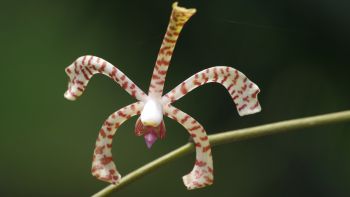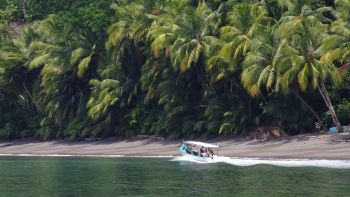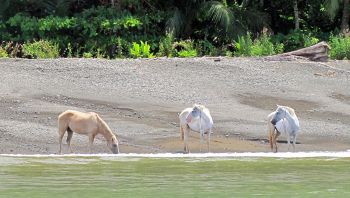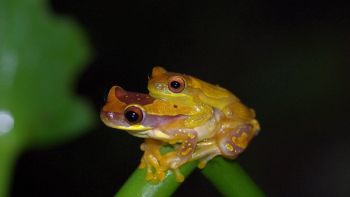In 1991, the Esquinas forest in southern Costa Rica, one of the last unprotected lowland tropical rainforests on the Pacific coast of Central America, was declared a national park by presidential decree. However, since all land was in private hands, it could only be catalogued as a "paper park" until it was owned by the Costa Rican national park service. Exploitation permits to use these lush forests had been issued before the declaration of the park and deforestation actually continued, inflicting irreversible damages upon the Esquinas Forest and jeopardizing the objectives of the decree.
Later that year, Michael Schnitzler, a well-known classical violinist from Vienna and part-time resident of Costa Rica, founded a non-profit organization called "Regenwald der Österreicher" ("Rainforest of the Austrians") with the goal of raising funds to buy property in the Esquinas Forest. By 2005, over 15,000 mostly Austrian individuals had donated about EUR 2,000,000, enabling the purchase of about 31 square kilometres of rainforest.
The property, most of which had exploitation permits for logging, has been donated to the Costa Rican government and become part of new Piedras Blancas National Park; logging in these areas has ceased. "Rainforest of the Austrians" has also donated funds to the National Park Foundation for the employment of park wardens, and to Zoo Ave and Pro Felis for the reintroduction of scarlet macaws, margays and ocelots into the Esquinas forest. In 1995, Michael Schnitzler received Austrian government's highest environmental award, the coveted Konrad Lorenz Prize. In 2000, "Rainforest of the Austrians" was honoured with the prestigious, $ 30,000 Binding Environmental Prize in Liechtenstein. Michael Schnitzler is also Honorary Member of the Costa Rican National Park Service.
Alongside this purchasing of land "Rainforest of the Austrians" is running the Esquinas Rainforest Lodge, which is an important employer for the people of neighbouring La Gamba village. The third part of the project is the Biological Station La Gamba, which provides the scientific basis for research as well as protection activities. For example, researchers were able to identify more than 180 distinct tree species on a single hectare! This labels the Esquinas Rainforest one of the hot spots of biodiversity.
Frequently asked questions
How are donations put to use?
After the government of Costa Rica has evaluated the properties and our lawyers have made sure that there are no mortgages or legal problems, we make a sales contract with the owner. Properties with management plans for logging receive priority. The owners receive their payment directly from our organization, and the property is registered in the name of our Costa Rica-based organization "Bosque de los Austríacos". Later, properties are donated to the Piedras Blancas National Park authority and thereby automatically become part of this National Park. Every square inch of property purchased since 1992 is supported by exact, detailed documentation. A contract with the Ministry of Environment, signed January 31, 1992, guarantees that donations from "Rainforest of the Austrians" may only be used for land purchase in the Esquinas Rainforest.
How is the Esquinas rainforest protected?
Presently (2004), only six park rangers are employed by the Costa Rican Park Service, two of them are paid by Rainforest of the Austrians. There is a plan to increase this number. Despite the fact that there are so few rangers, the park is relatively well-protected, because it is difficult for illegal loggers or hunters to access the heart of the Esquinas forest. It is no coincidence that, of all wilderness areas in Costa Rica, the Esquinas rainforest has been chosen for the reintroduction of endangered species. Environmental education projects for the local population are being undertaken by the Fundación Neotrópica and are being financed by Austrian Development Aid funds. The goal is to teach the people that a protected and unharmed forest has a far higher value than a logged forest. One of the sustainable development projects in the Esquinas forest is Esquinas Rainforest Lodge, from which all profits are invested into the community projects.
How much has been donated and how much is still missing?
Altogether, thousands of mainly Austrian citizens, countless schools, as well as companies and sponsors have donated € 3,235.416,56 to Rainforest of the Austrians. Between 1991 and 2009, Rainforest of the Austrians has bought land for € 1,849.411. Less than 20% of all donations have gone into PR, office expenses, printing, postage, banking fees. Together with land bought by the Costa Rican government and two U.S. NGOs, a total of around 70% of the Esquinas rainforest has been purchased.
What kind of animals live in the Esquinas rainforest?
Around 140 mammal species (including jaguars, ocelots, three kinds of monkeys, coatimundis, anteaters, and sloths), 100 species of reptiles and amphibians (including the rare South Pacific bushmaster, several species of poison-dart frogs, caimans and crocodiles), 350 species of birds, and more than 6000 kinds of insects live in the Esquinas Rainforest. Besides, the underwater world of Golfo Dulce has an immense variety of fish, like colorful reef fish, world-record sailfish and marlin as well as dolphins and even occasional whale sharks. Rainforest of the Austrians supports an exemplary project which is dedicated to freeing confiscated animals which have been held in captivity. The well-known organization "Zoo Ave" has successfully reintroduced hundreds of parrots (including 48 scarlet macaws) into the forest where they once lived before they were hunted or poached to near-extinction. The ultimate success depends on whether the birds will breed and multiply.
Can the National Park be dissolved?
Since 1948, 26% of Costa Rica's total land mass have been put under some kind of protection, either as a National Park, a Forest Reserve, or a Private Reserve. No other country has such a high percentage of protected land, and never has a protected area been dissolved. Costa Rica's National Park system is it's pride and trademark, and revenues from tourism have even surpassed income from traditional sources like coffee, bananas, or pineapples. The fact that the Republic of Costa Rica itself has purchased 3400 hectares of land in the Esquinas rainforest is the best guarantee that the government does not intend to dissolve the National Park.
How can I visit Piedras Blancas National Park?
Esquinas Rainforest Lodge is the only entrance to the park which is accessible by road. The trail system departing from the lodge measures 10 miles in length and leads through primary and secondary lowland tropical rainforest. Amadeus travel agency offers tours or packages which include Esquinas Rainforest Lodge on their itinerary.
Rainforest of the Austrians
Purchases since 1992
From 1992 until 2005, Rainforest of the Austrians has purchased 3093 hectares (7644 acres) of land in the Esquinas Forest. Together with land purchased by The Nature Conservancy (398 ha/983 ac) the U.S. hydroelectric company Tenaska (2.123 ha/5246 ac) and the government of Costa Rica (3.413 ha/8434 ac), roughly 61% of the whole area have been purchased. Most of the properties have already been donated to the National Park Service of Costa Rica, while a few are still in the process of being registered. Piedras Blancas National Park closes the gap between Golfo Dulce Forest Reserve and Golfito Wildlife Reserve, creating a 800 km² (309 mi²) corridor which stretches all the way around Golfo Dulce and connects with Corcovado National Park

We would like to thank all our guests who have been travelling with us since 1994 in the most beautiful time of the year - their well-deserved holidays. When developing itineraries for groups and individual travelers, selecting our local service partners and caring about the well-being of our guests, we always focus on the highest possible quality standards. Since the founding of Amadeus Travel, we have been committed to sustainable tourism as the only long-term viable form of tourism, e.g. through our social commitment, visiting and supporting private and state nature reserves as well as the training of our team and experienced, fully licenced tour guides.











 Book Now
Book Now 








